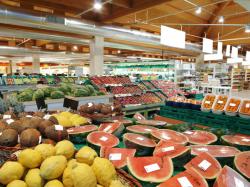Packaged Facts: Values Meals – Emerging Trends In Eco-Eating
August 27, 2013 | 4 min to read

Rockville, MD — Thanks to growing consumer awareness about the vulnerable state of the global environment and food supply, environmentally conscious eating is a trend destined to increase in urgency, according to Eco-Eating Culinary Trend Mapping Report by market research publisher Packaged Facts and the San Francisco-based strategic food consultancy CCD Innovation.
Consumers are continuing to educate themselves about ecologically sound foods and to look for new trustworthy partners in their pursuit to eat in ways that are kinder to the planet. This eco-eating takes many forms, typically starting with organic dairy and produce and moving on to plant-based proteins. In the past, it may have been sufficient to stop there and call it an eco-progressive meal plan. Now, according to Kimberly Egan, CEO of CCD Innovation, “Progressive diners and food shoppers are beginning to think about their eco-eating foot prints and are looking for sustainable choices in all sorts of new places.”
Eco-Eating has long been cultivated by natural grocery stores, which allows consumers to shop knowing that their values are reflected on the shelves and that they can trust that the meat, fish, dairy, produce and packaged products are made in accordance with a certain set of ecological and sustainable standards. Consumers are now looking farther afield, to restaurants, hotels and retail stores of all kinds for more eco-friendly food choices.
The sustainability trends covered by the Eco Eating Culinary Trend Mapping Report range from several cutting edge trends which may seem a bit far out, like edible packaging and eating insects, to familiar meat alternatives now going more globally authentic and flavorful. These trends are moving closer to the mainstream all the time thanks to creative entrepreneurs, progressive chefs, and consumers on a mission. The report profiles these seven trends:
· Edible Packaging: Forward-leaning entrepreneurs are already launching edible wrappers to help reduce the cost and impact of food packaging. Fruit, ice cream yogurt and even sandwiches will soon be available wrapped in innovation.
· Protein-Packed Insects: The buzz is growing around tapping into the protein insects can readily provide a hungry planet. These critters are already an accepted part of many global cuisines; look for creative cooks and global environmental organizations to join in the rallying cry for more buggy bites.
· Restaurant Gardens & Hotel Beehives: Fine dining chefs are joining hotel chains to plant rooftop gardens and raise honeybees to create ultra-local food supplies and inspire seasonal menus.
· New Sustainable Seafood Choices: Chefs and restaurateurs at all levels are working with seafood certification boards to obtain sustainably raised seafood, whether from the ocean or a fish farm, and looking deeper into the sea for new types of fish, big and small, that can be transformed into delicious fare.
· Grass-Fed Beef: A number of chain restaurants are leading the industry by securing grass-fed beef supplies for tacos, burgers and sandwiches, showing other companies that where there is a demand, a supply can rise to fulfill it. And with the cost of beef today, grass-fed costs have become enticingly competitive.
· Meatless Family Meal: Campaigns like the one for Meatless Mondays have had a significant impact on foodservice institutions as well as on household habits. Home cooks are turning to meatless casseroles, one-pot meals, stews, pastas and bean-based dishes to feed their families in healthful and sustainable ways.
· Today’s Tofu: This interest in non-animal protein has also fueled a growing trend for tofu, long a health food staple but now often seen as an authentic element of Asian cuisine as well as a flavorful base for meals of all kinds.
Amid these trending solutions to eco-eating, the issue of trust remains. When feasible, according to the Eco-Eating Culinary Trend Mapping Report, marketers should enhance and support menu items and food products by having them certified by respected agencies. For seafood, the Monterey Seafood Watch program is well known and has a consumer-friendly smartphone app. There are also groups for certifying farmed fish, grass-fed beef, non-GMO tofu and whole grains. Marketing efforts, cooking tips, and waiter or cashier training in restaurants will also help ensure that eco-friendly foods are recognized and understood by consumers grappling with a confusing marketplace.
For more information on Eco Eating Culinary Trend Mapping Report, please visit: http://www.packagedfacts.com/Eco-Eating-Culinary-7710822/
The Culinary Trend Mapping Report is co-published by CCD Innovation and Packaged Facts. Individual issues and annual subscriptions are available at www.packagedfacts.com/landing/culinarytrends.asp.
About CCD Innovation — CCD Innovation is a full-service food and beverage strategic innovation company that successfully blends culinary creativity with consumer insights, trends and marketing expertise. Visit www.ccdinnovation.com, or contact Lee Carstens at CCD Innovation at (415) 693-8900.
About Packaged Facts — Packaged Facts, a division of MarketResearch.com, publishes market intelligence on a wide range of consumer market topics, including consumer goods and retailing, foods and beverages, demographics, pet products and services, and financial products. Packaged Facts also offers a full range of custom research services. To learn more, visit: www.packagedfacts.com. Follow us on Facebook, Google+, Twitter, and http://packagedfacts.blogspot.com/
Source: Packaged Facts
